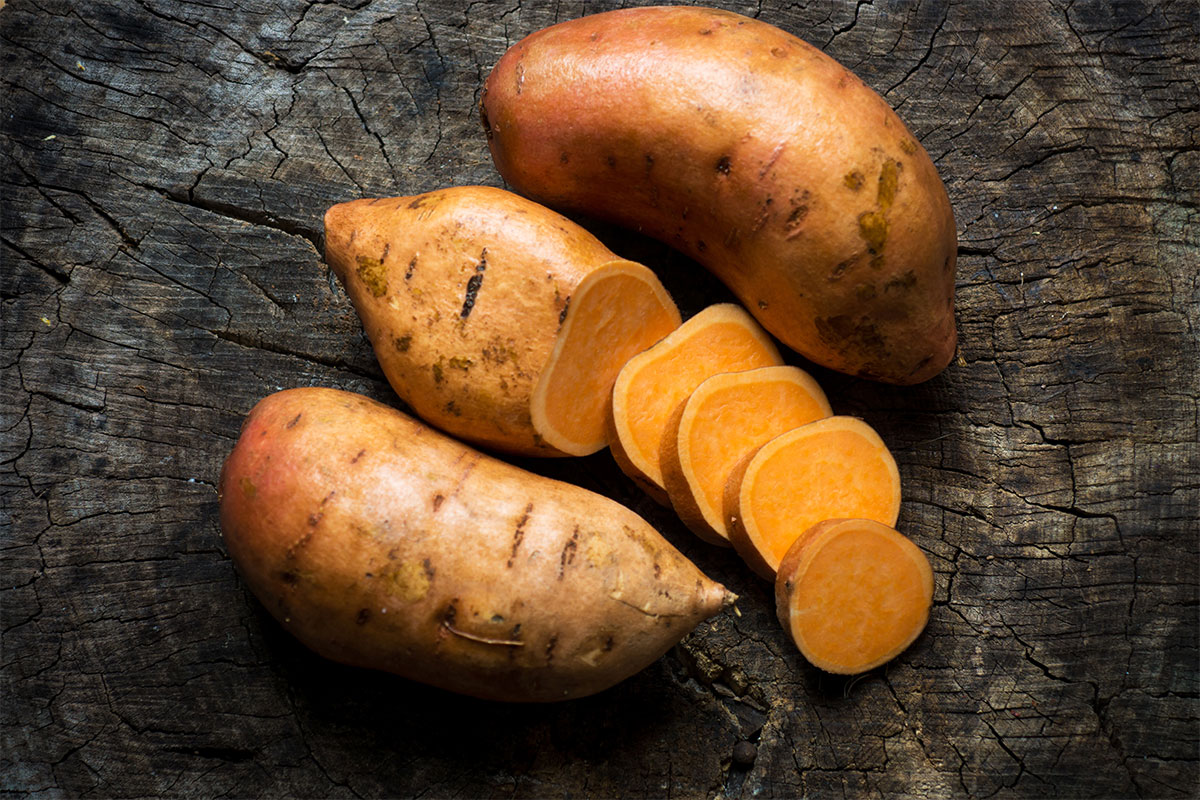Nutritious Green Foods You Didn’t Know About
Good nutrition is all about variety! Browse through our list of unusual fruits and veggies and give yourself a chance to try something new.


Could you recommend any best practices, storage methods, perishable and non-perishable food items, protein shakes, or other helpful tips for flight attendants or airline crew who desire to eat healthily but have limited access to refrigeration or healthy food options while on 3-5 day work trips?
– Ryjean R.

The two flight attendants I asked replied that they usually bring hard boiled eggs, avocados, salsa, sealed chicken apple sausages, green smoothie singles, lots of sturdy fruits like apples and oranges, nuts and seeds, carrots, jicama, and celery sticks with almond butter. For meals: vacuum-packed brown and white rice (can be served cold with cheese cubes and peas/corn), pasta salad with diced ham, or some frozen items like homemade casseroles or chicken curries – microwave required. Having a good cooler is essential!
Also see our previous answer to another flight question – What meals can I pack that will keep for up to 5 days, and that will help me lose weight?
– Debbie J., MS, RD
This article should not replace any exercise program or restrictions, any dietary supplements or restrictions, or any other medical recommendations from your primary care physician. Before starting any exercise program or diet, make sure it is approved by your doctor.
Some questions have been edited for length and/or clarity.
 Have a nutrition question? Our registered dietitian is ready to help!
Have a nutrition question? Our registered dietitian is ready to help!
Email nutrition@lafitness.com or submit your question below and it may be featured in an upcoming article!
Good nutrition is all about variety! Browse through our list of unusual fruits and veggies and give yourself a chance to try something new.
Does liberally salting your food help you pump more iron in the gym? Registered Dietitian, Debbie James, investigates the claims!
One frequently asked question is about the recommended intake of protein. We hear you! Here is everything you need to know.


Does camphorated oil burn fat?
– Margaret

Camphor is an insoluble, waxy, flammable, white or transparent solid with a strong aroma (typically from Asian evergreen trees or basil) that is used in skin balms and liniments.
You may get a different answer from a company or person promoting sales of it, but nutritionally camphor oil has NO proven effect on weight status, metabolism or body fat. Oral intake is not recommended as side effects include mouth and throat burning, nausea and vomiting. Ingestion of camphor can lead to coma and death.
Note that in the 1980s, “camphorated oil” (20% camphor in cottonseed oil) was removed from the US market because of safety concerns. Use of products containing more than 11% camphor is not recommended. Diluted camphorated oils are only for topical or aromatic use in the treatment of infections, cold/cough, and respiratory disorders, sleeplessness, skin conditions, pain and swelling.
Resources:
– Debbie J., MS, RD
This article should not replace any exercise program or restrictions, any dietary supplements or restrictions, or any other medical recommendations from your primary care physician. Before starting any exercise program or diet, make sure it is approved by your doctor.
Some questions have been edited for length and/or clarity.
 Have a nutrition question? Our registered dietitian is ready to help!
Have a nutrition question? Our registered dietitian is ready to help!
Email nutrition@lafitness.com or submit your question below and it may be featured in an upcoming article!
Good nutrition is all about variety! Browse through our list of unusual fruits and veggies and give yourself a chance to try something new.
Does liberally salting your food help you pump more iron in the gym? Registered Dietitian, Debbie James, investigates the claims!
One frequently asked question is about the recommended intake of protein. We hear you! Here is everything you need to know.

“Rich in vitamins, minerals, phytonutrients, fiber & antioxidants, plant-based foods lower cholesterol and decrease the risk of heart disease, cancer, diabetes, kidney disease & obesity. Plant protein is more varied than meat protein and offers a much wider variety of options for creating innovative, healthful menus. Sophisticated vegan cuisine is the new frontier. There is so much undiscovered potential in this arena. The focus at Elizabeth’s Gone Raw is to create monthly a seven-course tasting dinner comprised of organic plant-based ingredients. It is our intention to offer the public an indulgent healthy dining experience, visually exciting, sensual and provocative.”

Photography by: Greg Powers

Photo credit: Belathee Photography
Elizabeth’s Gone Raw is located at the following location:
Distance to closest LA Fitness: 0.8 miles to Connecticut Ave. LA Fitness
Elizabeth’s Gone Raw is located at 1341 L St NW, Washington, DC 20005. Open Friday from 5pm to 12am. For reservations, menu, and additional details, please visit elizabethsgoneraw.com.

Photography by: Greg Powers


For the Strawberry Gazpacho
For the Fermented Carrot Quenelle
Optional
This soup is topped with olive tapenade which is optional.
Step 1: Blend together the ingredients for the Fermented Carrot Quenelle, then cover with parchment paper and let ferment at room temperature for two days. Form in the shape of a quenelle using two teaspoons and place in the bottom of the bowl.
Step 2: Blend together in a Vitamix (or blender) all the ingredients for the Green Strawberry Gazpacho.
Step 3: This soup is topped with olive tapenade which is optional.
Step 4: Enjoy!
Featured Recipes
Good nutrition is all about variety! Browse through our list of unusual fruits and veggies and give yourself a chance to try something new.
Does liberally salting your food help you pump more iron in the gym? Registered Dietitian, Debbie James, investigates the claims!
One frequently asked question is about the recommended intake of protein. We hear you! Here is everything you need to know.


I’ve had my body fat tested via Dexascan and my metabolism calculated via a breathing test. The determination was that I should be consuming no more than 2,103 calories and no fewer than 1,700 calories daily.
I prefer to eat only 1,700 calories whenever possible — and work out (weights & cardio) a few days each week in order to create an even greater deficit. It’s my understanding that, for me, eating fewer than 1,700 calories daily can result in a “starvation response” whereby I’ll actually retain fat instead of burning it.
My Question: Since fiber isn’t used for energy or stored — but is counted as a carb worth 4 calories/gram on nutritional labels and calorie-tracking apps — should I deduct from my daily totals the caloric value of the fiber I eat in order to stay out of “starvation mode”?
For example, say I’ve eaten 1,700 calories today, but that included 35g of fiber, which equals 140 calories. That dips my actual daily calories roughly 10% — to 1,560 — and into the starvation-mode territory. Should I compensate for those “missing” fiber calories with more food, or is my logic flawed and fiber actually DOES count toward my macros/calories?
– Darin S.

Great question, Darin! Fibers are non-digestible carbohydrates from plant sources that may be fermented in the large intestine. Considered a subset of the total carbohydrate, dietary fiber is listed under carbohydrates on a Nutrition Facts panel. It includes both soluble and insoluble fiber, as well as lignin, whether naturally occurring or added.
Yes, since fiber is not digested (thus not used for energy or stored), it’s known to have less than the 4 calories per gram than other carbohydrates do. In fact, certain fibers offer almost 0 calories, while others provide only a smidge of energy after their fermentation by colonic bacteria. The Food and Drug Administration estimates that fermentable fibers provide about 2 calories per gram. Manufacturers may subtract the insoluble fibers when calculating energy, but not soluble fiber grams. Half of your stated 140 calories calculated from the fiber may already have been considered on food labels, leaving only 70 calories or 4% of your daily target of 1,700.
My recommendation would be to not compensate for any “missing” fiber calories, as people, in general, tend to under-report food intake when tracking and diet analysis calculations are already inaccurate by 10%. Maintain your protein intake when restricting calories and I’d suggest bumping your pre- or post-exercise nutrition up by 100 calories on your workout days.
Rather than focus on fiber in calorie-counting accuracy, readers should instead focus on getting the recommended amount of fiber each day, which has recently increased. As of 2016, the FDA the daily reference value of fiber was raised from 25 grams to 28 grams.
Resource
– Debbie J., MS, RD
This article should not replace any exercise program or restrictions, any dietary supplements or restrictions, or any other medical recommendations from your primary care physician. Before starting any exercise program or diet, make sure it is approved by your doctor.
Some questions have been edited for length and/or clarity.
 Have a nutrition question? Our registered dietitian is ready to help!
Have a nutrition question? Our registered dietitian is ready to help!
Email nutrition@lafitness.com or submit your question below and it may be featured in an upcoming article!
Good nutrition is all about variety! Browse through our list of unusual fruits and veggies and give yourself a chance to try something new.
Does liberally salting your food help you pump more iron in the gym? Registered Dietitian, Debbie James, investigates the claims!
One frequently asked question is about the recommended intake of protein. We hear you! Here is everything you need to know.


I have a question on sweet potatoes. Someone told me that eating one sweet potato before a workout is a great source of energy and it does not contain any bad cholesterol. What is your take on this?
– Nick C.

Sweet potatoes are a great source of energy! They are full of complex carbohydrates (25 grams = 100 calories) for lasting fuel with a little protein (approx. 2 grams per cup). Sweet potatoes do not contain any cholesterol or saturated fat. They have a good fiber content, providing 4 grams per medium potato, which is beneficial for watching your cholesterol.
They are so easy to microwave and eat with a spoon right from the peel when sliced length-wise. No condiments needed! Kept cold, chunks of cooked sweet potato can be dressed up to make savory or sweet. Avoid fried sweet potato pre-workout as you don’t need the added fat slogging you down and hampering performance.
Resource:
– Debbie J., MS, RD
This article should not replace any exercise program or restrictions, any dietary supplements or restrictions, or any other medical recommendations from your primary care physician. Before starting any exercise program or diet, make sure it is approved by your doctor.
Some questions have been edited for length and/or clarity.
 Have a nutrition question? Our registered dietitian is ready to help!
Have a nutrition question? Our registered dietitian is ready to help!
Email nutrition@lafitness.com or submit your question below and it may be featured in an upcoming article!
Good nutrition is all about variety! Browse through our list of unusual fruits and veggies and give yourself a chance to try something new.
Does liberally salting your food help you pump more iron in the gym? Registered Dietitian, Debbie James, investigates the claims!
One frequently asked question is about the recommended intake of protein. We hear you! Here is everything you need to know.
Be the first to know about exclusive
content, deals and promotions